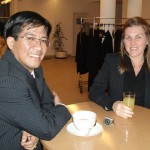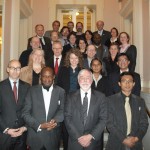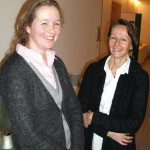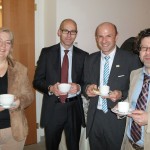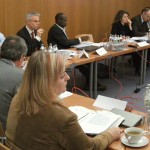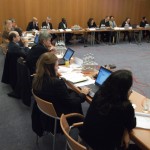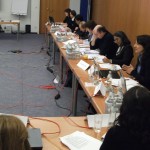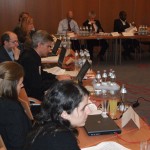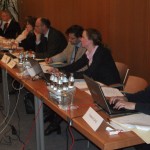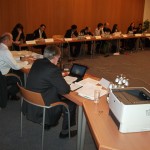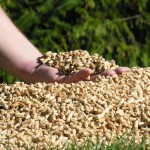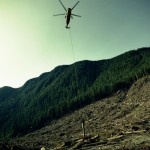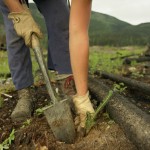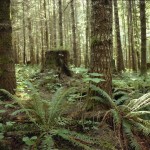Expert Panel on International Forest Regime (GFEP)
25 political scientists met in Vienna last week to start drafting the most comprehensive scientific report on the international forest regime. The report will be officially published in January 2011 on the occasion of the 9th session of the United Nations Forum on Forests.
More specifically, the assessment aims to contribute to
- the international forest deliberations and international forest-related processes such as the ninth session of the United Nations Forum on Forests (January 2011), the tenth Conference of the Parties of the Convention on Biological Diversity (October 2010), and the discussion on Reducing Emissions from Deforestation and Forest Degradation (REDD);
- the improvement of coordination among political actors, policy instruments and institutions;
- the International Year of Forests 2011 by raising awareness about the role of international instruments and institutions affecting forests.
PHOTOS FROM THE FIRST MEETING
Trees: A Low-Cost Climate Mitigation Tool
2nd in a series of releases relating to the XXIII IUFRO World Congress
(Vienna, 21 December 2009) – The forest sector has huge potential to mitigate the effects of climate change at low costs. The reason is that trees provide one proven way to remove CO2 from the atmosphere.
That opportunity makes it critically important to understand exactly which forest-related activities can contribute to mitigation benefits. Such understanding will then lead to a science-based dialogue about which activities contribute to climate change mitigation and which may make it worse. That will then lead to tools to support informed, responsible policy development.
“Reduction of emissions from deforestation and degradation is the most important first step, because it has an immediate impact,” says Dr. Werner Kurz, of the Canadian Forest Service, who notes that in the ‘90s, deforestation emissions globally were found to contribute an amount equivalent to about 20% of fossil fuel emissions.
Dr. Kurz, who will coordinate a session to explore the potential of forest sector activities to mitigate climate change at the 2010 IUFRO World Forestry Congress in Seoul, adds: “Biomass derived from forests contributes to meeting society’s demands for timber, fibre and energy. But further analyses are needed to help identify and implement the climate mitigation activities that deliver the greatest climate mitigation benefits.”
The issues are challenging and will foster lively, heated, discussion. As an example, some argue for conservation – keep the carbon in the forest because today’s carbon is what matters in the atmosphere. Others argue, among other things, using harvested biomass to store carbon in wood products and to use biomass from harvest residues or bioenergy plantations as sources of bioenergy to substitute for fossil fuels. To design an effective climate mitigation portfolio, carbon costs and benefits and their dynamics must be quantified over time, Kurz says.
Will northern forests be able to stand the heat?
Boreal forests are especially sensitive to global warming and are likely to be severely affected by climate change.
In international climate change negotiations, forest-related deliberations have so far mainly focused on mitigation, rather than adaptation. However, in the particularly vulnerable boreal regions, climate change is progressing too quickly to postpone adaptation action. Flexible approaches tailored to local situations must go hand in hand with substantial reductions of carbon emissions from fossil fuel and deforestation. Otherwise forests are at high risk of entirely losing their carbon-regulating services. This would, in turn, seriously accelerate climate change, a fact that has not yet been fully considered in current model generation.
|
Boreal and temperate forests: What will happen? What actions should be taken?
Learning Event – Organized by IUFRO and EFI (European Forest Institute) During Forest Day 3 in Copenhagen (UNFCCC-COP15)
Boreal and temperate forests are likely to be particularly affected by climate change because they are generally temperature-limited. With climate change advancing, their role as a major sink for atmospheric carbon is at risk. This session informed participants about this and other key impacts and vulnerabilities and discussed adaptation priorities and implications for forest management. The learning session also explored how lessons from the EU programme Forest Law Enforcement, Governance and Trade (FLEGT) could be used for forest-based climate change mitigation and adaptation.
Forests, Livelihoods & Climate Change
A side event organized during the United Nations Climate Change Conference in Copenhagen (COP15)
This joint event organized by IUFRO, ITTO (International Tropical Timber Organization) and Intercooperation (Swiss Foundation for Development and International Cooperation) will address the ongoing and new activities to promote social, economic and environmental benefits of forests that contribute to sustainable livelihoods in the framework of climate change mitigation, adaptation and ecosystem restoration.
Programme
Introduction
Introduction to the side event (Mr. Alexander Buck, IUFRO Deputy Executive Director)
–
International Tropical Timber Organization (ITTO)
ITTO Thematic Programme on REDDES (Mr. Emmanuel Ze Meka, Executive Director of ITTO)
–
Voluntary Forest Carbon Offset Projects in Japan (Mr. Noriuki Kobayashi, Professor of Nihon University Law School, Japan)
–
Public-Private Partnership to promote REDD+ in Meru Betiri National Park, Indonesia (Ms. Nur Masripatin, Director of FORDA, MoF, Indonesia)
–
Intercooperation
Making REDD Happen in Reality – Experiences from the REDD-FORECA Pilot Project in Madagascar (Ms. Julia Randimbisoa – Climate change focal point in Madagascar)
–
International Union of Forest Research Organizations (IUFRO)
Will Forests Be Able to Stand the Heat? Main results of a global assessment (Mr. Peter Mayer, IUFRO Executive Director)
–
Making African Forests Fit for Climate Change – Key messages to policy and decision makers (Mr. Stephy David Makungwa, Chair of thematic group “Forests and Climate Change” of the Forestry Research Network for Sub-Saharan Africa)
–

